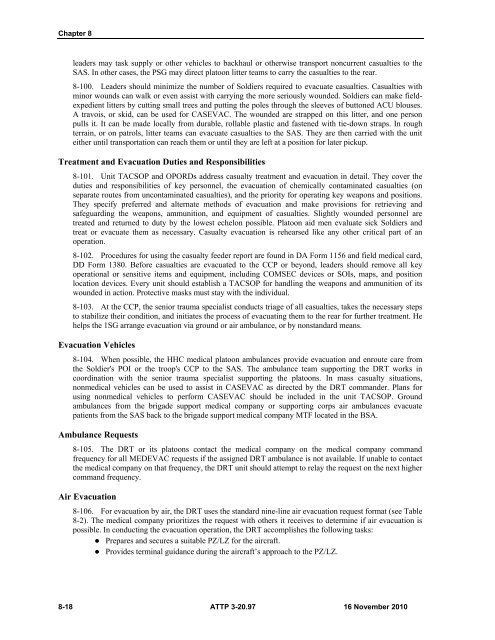Dismounted Reconnaissance Troop - Army Electronic Publications ...
Dismounted Reconnaissance Troop - Army Electronic Publications ...
Dismounted Reconnaissance Troop - Army Electronic Publications ...
You also want an ePaper? Increase the reach of your titles
YUMPU automatically turns print PDFs into web optimized ePapers that Google loves.
Chapter 8<br />
leaders may task supply or other vehicles to backhaul or otherwise transport noncurrent casualties to the<br />
SAS. In other cases, the PSG may direct platoon litter teams to carry the casualties to the rear.<br />
8-100. Leaders should minimize the number of Soldiers required to evacuate casualties. Casualties with<br />
minor wounds can walk or even assist with carrying the more seriously wounded. Soldiers can make fieldexpedient<br />
litters by cutting small trees and putting the poles through the sleeves of buttoned ACU blouses.<br />
A travois, or skid, can be used for CASEVAC. The wounded are strapped on this litter, and one person<br />
pulls it. It can be made locally from durable, rollable plastic and fastened with tie-down straps. In rough<br />
terrain, or on patrols, litter teams can evacuate casualties to the SAS. They are then carried with the unit<br />
either until transportation can reach them or until they are left at a position for later pickup.<br />
Treatment and Evacuation Duties and Responsibilities<br />
8-101. Unit TACSOP and OPORDs address casualty treatment and evacuation in detail. They cover the<br />
duties and responsibilities of key personnel, the evacuation of chemically contaminated casualties (on<br />
separate routes from uncontaminated casualties), and the priority for operating key weapons and positions.<br />
They specify preferred and alternate methods of evacuation and make provisions for retrieving and<br />
safeguarding the weapons, ammunition, and equipment of casualties. Slightly wounded personnel are<br />
treated and returned to duty by the lowest echelon possible. Platoon aid men evaluate sick Soldiers and<br />
treat or evacuate them as necessary. Casualty evacuation is rehearsed like any other critical part of an<br />
operation.<br />
8-102. Procedures for using the casualty feeder report are found in DA Form 1156 and field medical card,<br />
DD Form 1380. Before casualties are evacuated to the CCP or beyond, leaders should remove all key<br />
operational or sensitive items and equipment, including COMSEC devices or SOIs, maps, and position<br />
location devices. Every unit should establish a TACSOP for handling the weapons and ammunition of its<br />
wounded in action. Protective masks must stay with the individual.<br />
8-103. At the CCP, the senior trauma specialist conducts triage of all casualties, takes the necessary steps<br />
to stabilize their condition, and initiates the process of evacuating them to the rear for further treatment. He<br />
helps the 1SG arrange evacuation via ground or air ambulance, or by nonstandard means.<br />
Evacuation Vehicles<br />
8-104. When possible, the HHC medical platoon ambulances provide evacuation and enroute care from<br />
the Soldier's POI or the troop's CCP to the SAS. The ambulance team supporting the DRT works in<br />
coordination with the senior trauma specialist supporting the platoons. In mass casualty situations,<br />
nonmedical vehicles can be used to assist in CASEVAC as directed by the DRT commander. Plans for<br />
using nonmedical vehicles to perform CASEVAC should be included in the unit TACSOP. Ground<br />
ambulances from the brigade support medical company or supporting corps air ambulances evacuate<br />
patients from the SAS back to the brigade support medical company MTF located in the BSA.<br />
Ambulance Requests<br />
8-105. The DRT or its platoons contact the medical company on the medical company command<br />
frequency for all MEDEVAC requests if the assigned DRT ambulance is not available. If unable to contact<br />
the medical company on that frequency, the DRT unit should attempt to relay the request on the next higher<br />
command frequency.<br />
Air Evacuation<br />
8-106. For evacuation by air, the DRT uses the standard nine-line air evacuation request format (see Table<br />
8-2). The medical company prioritizes the request with others it receives to determine if air evacuation is<br />
possible. In conducting the evacuation operation, the DRT accomplishes the following tasks:<br />
Prepares and secures a suitable PZ/LZ for the aircraft.<br />
Provides terminal guidance during the aircraft’s approach to the PZ/LZ.<br />
8-18 ATTP 3-20.97 16 November 2010

















